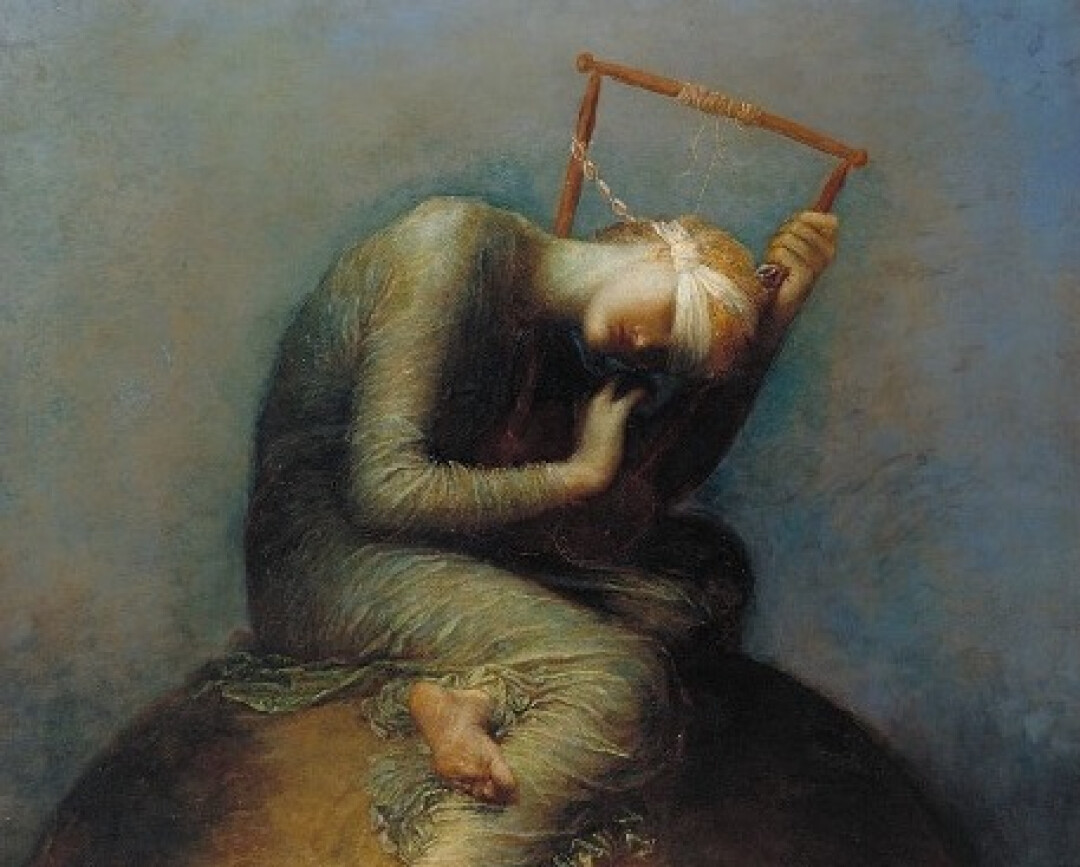
by Donny Abbott on January 15, 2024

In 1886, British artist George Frederic Watts wrote a letter to a friend to tell him about his initial thoughts on an art project he was working on:
“Hope sitting on a globe, with bandaged eyes, playing on a lyre which has all the strings broken but one, out of which poor little tinkle she is trying to get all the music possible, listening with all her might to the little sound.”
Watts was inspired to paint this work as a way to cope with the grief he was experiencing after the sudden death, a year earlier, of his one-year-old granddaughter. After her passing, Watts was completely inconsolable to the point that he wrote in another letter, “I see nothing but uncertainty, contention, conflict, beliefs unsettled, and nothing established in place of them.”
Many of us can relate to his feeling of hopelessness.
What he produced is a hauntingly beautiful painting titled “Hope.” Art historian Malcom Warner described the painting by stating:
“She strained to listen to the sound of the single, unbroken string, symbolizing both persistence and fragility and the closeness of hope and despair.”
Subscribe to the Timberline Church Blog
As we see in the painting “Hope,” when all of the other strings are broken and gone, she is still plucking that one string left on her lyre.
The painting was not well received by art critics. One critic said it should have been titled “Despair.” Another wrote:
“Deary! A young woman tying herself into a knot and trying to perform the chair trick. She is balanced on a pantomime Dutch cheese, which is floating in stage muslin of uncertain age and color. The girl would be none the worse for a warm bath.”
In spite of what the critics thought, it was well-received by the general public and copies of it found a place on numerous hallway walls in homes around the world.
I have also found it to be a deeply moving piece as it reminds me that even in the midst of lament, we can still find hope.
This is the same theme the prophet Jeremiah wrote about 2,500 years ago:
“The steadfast love of the Lord never ceases; his mercies never come to an end; they are new every morning; great is your faithfulness. ‘The Lord is my portion.’ says my soul, ‘therefore I will hope in him.’” — Lamentations 3:22-24
The Book of Lamentations is a book comprised of five poems with the backdrop to the book being the Babylonian invasion of Jerusalem that occurred in 586 BC. At the time, the Babylonian King Nebuchadnezzar was the leader of the most powerful force in the world. He would go on to wield his power and bring neighboring nations to their knees so they would become subjected to him.
In Jerusalem, their King had decided to give his allegiance to Egypt, which didn’t make Nebuchadnezzar happy. So, Nebuchadnezzar decides to invade Jerusalem. But prior to his invasion, he set in place a three-year siege on the city. Upon the event of the invasion, he kidnapped tens of thousands of Jews and exiled them to present-day Iraq, while at the same time, he completely destroyed the Jewish Temple. Think of what happened in Israel this past October but on a grander scale.
So, that’s the backdrop to Lamentations and what Jeremiah witnessed in this exile was utter despair amongst the Jewish people. A people who was filled with grief and loss, pain, denial, shock, and heartache. They would go on to suffer a great deal of affliction and hard labor in their exile.
In spite of the tumult that Jeremiah and his people were experiencing, he still clung to the fact he was going to hope in God.
But of course, this is easier said than done, isn’t it? Because what you’re seeing in your life right now isn’t looking so good. You might be holding out hope for relief from physical pain and discomfort. Perhaps you’re hoping for a complete healing or resolution of a relational conflict you’re involved with or you’re hoping God will provide you with a job.
There is a balance to hope, though, isn’t there? It’s almost mysterious. On one hand, you’re holding out hope for things; restoration, healing, provision. But we know that many times, what we hope for doesn’t come to fruition. At least, not as we envisioned.
Martin Luther King Jr. put this tension into focus once in a sermon where he said, “The answer lies in developing the capacity to accept the finite disappointment and yet cling to the infinite hope.”
As Christians, the hope we have is found in Jesus, the One who provides healing, provision, and restoration. And who, because of His death and resurrection, provides us eternal hope.
Much like the young girl with bandaged eyes, blindly plucking the sole intact string of an instrument once capable of producing rich harmonies, we cling to Christ with all our might. We know our hopes will survive in His love. He who never ceases to heal us, provide for us, and restore us also makes us whole again, capable of producing our own spiritual harmonies that rival even the most beautiful music of the lyre.




